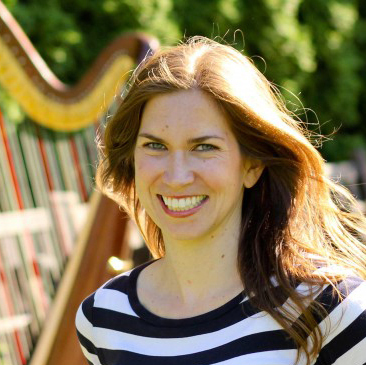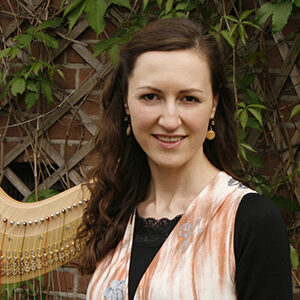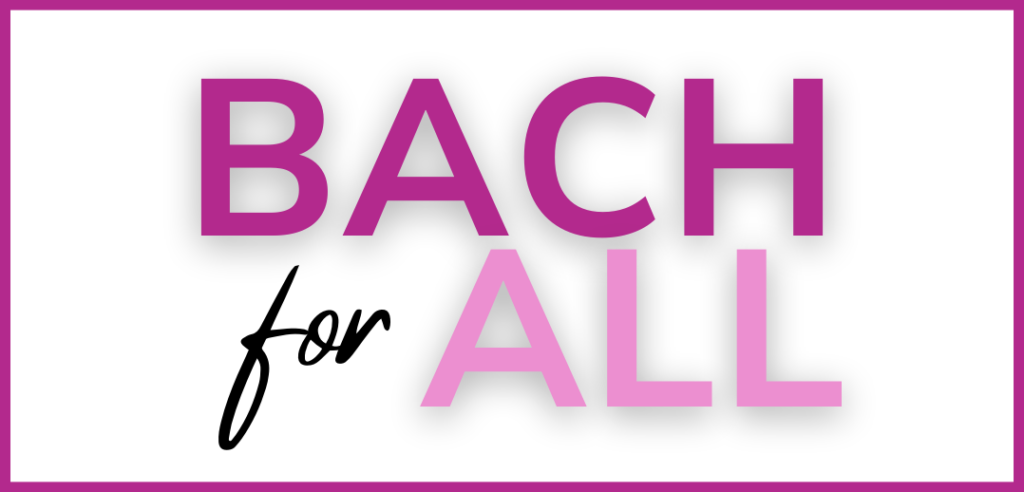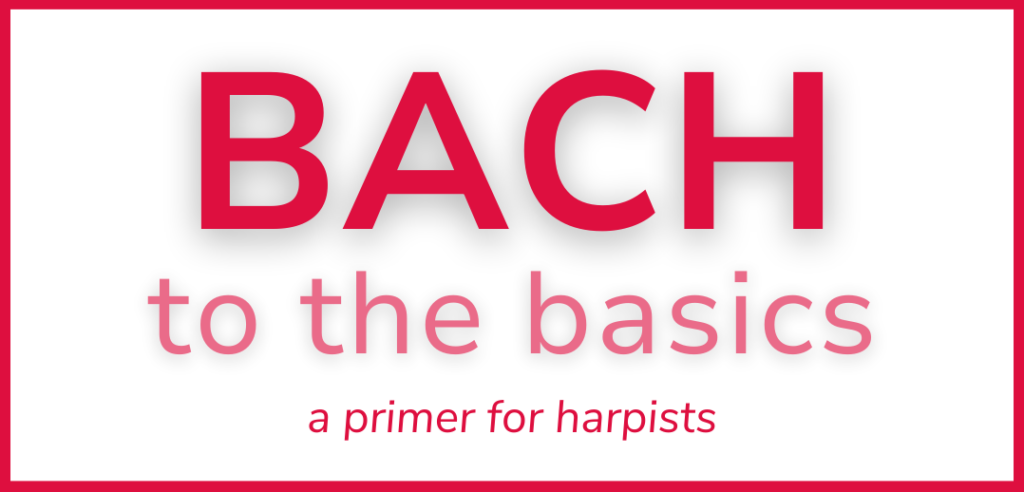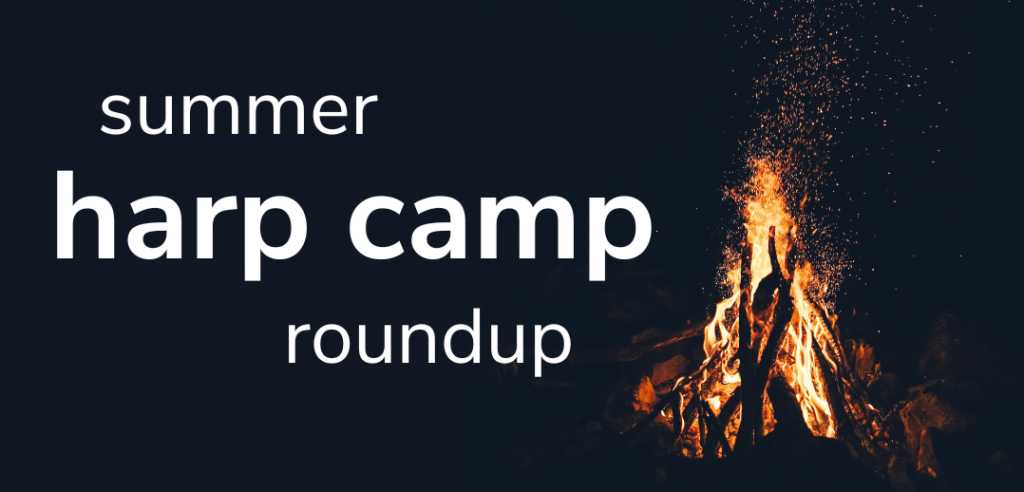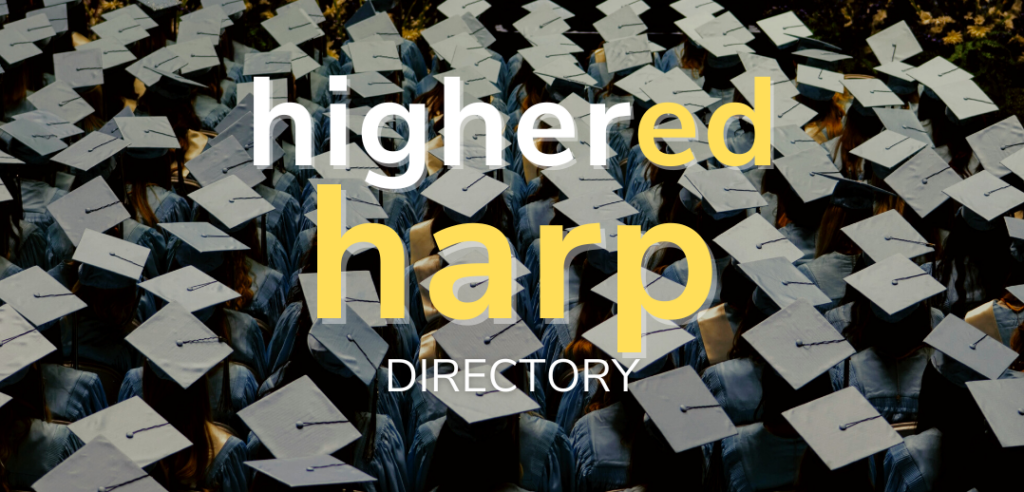Your first reaction to harplessness might be to throw up your arms and give up. But being a harpist goes far beyond sitting behind the instrument. There are plenty of ways to better your harp life sans harp.
There are many reasons why you may find yourself taking a forced break from the harp. Injury and illness are both obvious culprits. Playing the harp is such a physically demanding activity that any injury, not just to your hands or arms, could potentially prevent you from playing. Travel can be another cause of temporary harplessness—the harp is not only famously unwieldy to transport, but also uncommon enough that there’s probably not one sitting around in your hotel lobby. Or maybe your harp is the one with the injury, out of commission until you can make it to a technician. Perhaps you don’t own a harp yourself and have limited practice time on a school harp. These are circumstances you usually can’t control; life simply throws them your way. What you can control is how you deal with the situation. Do you use your harplessness as an excuse to drop what you were working on? Or do you see it as a creative challenge to find an alternate route toward your goal?
Back in my college days, as an undergraduate music major, I had my own brief experience without a harp. It was an injury that forced me to take about a week away from the instrument. I had recently moved apartments—a physically strenuous endeavor involving lugging boxes of cheap dishes, college hoodies, and music textbooks across campus—and shortly thereafter, my back went out. Now, I don’t know if to go “out” is a real medical term, but it was a very real problem for me. From one moment to the next, I couldn’t walk anymore or even sit up—it was too painful. The only position I could handle was lying flat on my back. To add to the pain, the injury happened when I was in the middle of preparing for an important competition. I couldn’t afford to take time off from practicing, so I had to get creative.
…going harpless can be the perfect opportunity to relax and work those unwanted sources of tension out of your body.
The reality is that injuries happen, everybody gets sick at one point or another, but we also recover. The first thing to do if you find yourself in a harpless situation is define what exactly you can’t do so that you can start getting creative about what you can do. Just recently, a student texted me before her lesson saying that she may need to cancel because she had gotten a cut on the third finger of her right hand, right where it would normally touch the string. Ouch! “That’s tough luck,” I was thinking, as I went to my calendar to cross off the lesson for that day, but then I thought, “Wait a minute. This injury means that, until the cut heals, she can’t play with her third finger. But the rest of her fingers are fine!” We decided together that she should still come to her lesson, and we had a great time working on her left hand, singing phrases, and tapping out rhythms. We even adapted her right-hand technique exercises with unusual fingerings involving only 1, 2, and 4. That was a brain twister and a new challenge for her fingers. The main lesson of that day, however, was that not all injuries are as big a setback as they might at first seem.
Of course, everyone’s circumstances and goals are unique, and there are as many solutions to the puzzle of how to practice without a harp as there are harpists. If you find yourself harpless, we have a wealth of ideas for you, no matter where you are in your harp journey. Hopefully, you’ll read an example here that you can adapt to fit your own needs or an idea that inspires you to come up with your own creative solutions.
Tips for beginners
While you’re away
Look to web and smartphone apps to improve your music skills when you’re not able to play your harp
• Free Online Music Theory Lessons musictheory.net
• Music Tutor note reading smartphone app
• Music Theory Helper smartphone app to learn chords, scales, and symbols
• Complete Ear Trainer smartphone app to build listening skills
For those who are just starting out with the harp, or with music in general, your main focus should mostly be on building a solid foundation. A comfortable playing technique and a good understanding of music fundamentals are the starting points for everything you may hope to achieve with the harp. If you have to go harpless this early on in your journey, it can be daunting to figure out how to move forward without any previous experience to guide you. Fortunately, there’s so much to learn in the beginning—both at and away from the harp—that almost any musical activity you choose will be beneficial.
A beginning harpist on the user forums at harpcolumn.com, nicknamed GlissBliss, encountered such a situation and wrote, “I’m in a position where I won’t be able to purchase or rent a harp for about six months. Do you have any suggestions on how I can keep improving in the meantime?” The responses provided a spectrum of ideas and resources—it’s definitely worth reading the full discussion on the website—but perhaps the most common theme was on the benefit of studying music fundamentals.
Long-time forum contributor Carl Swanson wrote, “When anyone wants to learn a musical instrument, the teacher has to deal with teaching the student two different things: how to play the instrument, and how to read music. If the student already knows how to read music, then that’s a huge advantage. So, if you won’t have a harp to practice on for several months, then use that time to learn to read music. Find a teacher, preferably a solfege teacher, who can teach you music theory and reading lines and spaces efficiently. You don’t need a harp to do that. You don’t need any musical instrument. The better you can read music, the easier it will be to learn to play the harp.”
Some people suggested temporarily practicing with a more accessible instrument. User Walden wrote, “Get a digital keyboard—about $90—and one of the many basic musicianship/theory workbooks available.” Elettaria suggests learning to sing: “You don’t have to buy an instrument, but you get to learn the musicality and can focus on getting past the basics of learning to read. I was put into a choir at the age of 9, one which sang challenging 20th century music, and the benefits have been incalculable. Being a good sight-reader opened up so much music to me.”
Certainly, a music teacher is the best resource, especially in the beginning stages of your musical development, but there are many other resources that can serve as supplements in specific areas and give motivation on a daily basis through educational music websites, blogs, and apps.
Another important activity that beginners can do away from the instrument is explore the harp’s repertoire. Walden adds, “Listen to a lot of music. Figure out what songs you want to learn how to play and listen to them repeatedly, so the tempo, volume, accents, notes, and rhythm become ingrained in your head. That way, it will be easier to reproduce and recall once you regain access to a harp.” You can listen to nearly anything online these days, but why not also check out a live performance? One forum participant writes, “Live recitals at university music schools are an interesting and enjoyable way to spend one’s time if you have access to them. The recitals are often open, and attendance is encouraged among students and the public to help the aspiring musician.”
Take your listening a step further and pull out your score to read along. Take the time to do an analysis of the piece, noting the main key and the rhythmic meter, marking the chord functions (I IV V) and any key changes, and figuring out how the piece is structured. Label the different sections (A, B, C, etc.), and notice if any sections are repeated (e.g. A B A). As a harpist, you can also save yourself time later by writing in any pedal or lever changes. If you don’t know how to do all of this yet, don’t worry. Just do whatever you know, and the rest will come later. Even if you just try to read the names of the notes out loud, that will benefit your sight-reading skills.
What if you’ve got all the above covered, but your fingers are still itching to get into action? Then, I would suggest having a look at the mesmerizing feats of finger independence and fitness guru Greg Irwin. He has developed a set of finger exercises that can benefit any instrumentalist. Harpist Gretchen Cover gave them a try and found, “It helped my playing immensely. I even did a test in which I played a piece once, put it away and came back to it after doing finger fitness for a couple weeks. I was amazed how much better I could play the piece just from doing these exercises.”
Beginners can start laying the bricks of their musical foundation without an instrument to play. Learn music theory—note reading, rhythms, sight-reading, keys, chords, etc. Study the harp’s repertoire by listening to and reading the scores of pieces you are interested in learning. Finally, get a head start on your finger coordination and flexibility by practicing some finger independence exercises.
Advice for experienced players
Once you have several years of experience under your belt, you have probably developed a good familiarity with the instrument and the muscle memory for harp technique. At this stage, your goals likely involve learning new pieces and continuing to improve and refine your skills.
That was the position I found myself in when I suffered the back injury I described earlier. I had a large amount of music that I needed to refine and memorize, but I couldn’t sit up to practice. Instead, I turned my efforts to mental practice.
For those who have never tried mental practice, the goal is to visualize yourself playing your piece (check out Emily Levin’s most memorable moment in “Unforgettable” on pg. 16 for a perfect example of mental practice). The richer in detail your visualization is, the better. You should be able to feel your fingers on the strings and your arms moving your hands between passages, know exactly which notes you’re playing and with what kind of expression, know where your pedals (or levers) are at any moment, keep track of where you are within the form of the piece, and breathe along with the phrases. The first time I do this with a new piece, I invariably find that my mental picture is not actually as complete as I thought it was. Maybe I know what my right hand is up to, but my left hand has apparently been on autopilot. Without the harp strings under my fingers, I’m not entirely sure what notes it’s supposed to be playing. I open my eyes and check the score. This is the best method for strengthening your memory and filling in your blind spots.
As if visualizing every detail of the piece wasn’t hard enough, the exercise is also a grueling test of concentration. You could be mentally playing through your piece and, minutes later, find yourself thinking about a conversation you had with your mother that morning, with no idea how you got so far off topic. When that happens (I say when and not if because it will happen), just calmly come back to your piece, wherever you left off. Fortunately, your concentration can and does improve with practice, and it’s a skill that will transform your confidence as a performer.
Isabelle Perrin, former harpist of the French Orchestre National and artistic director of the World Harp Congress, also has first-hand experience with going harpless due to an injury. Because of arthritis, she recently underwent surgery on her thumb, which left her unable to play for two years. “[The arthritis] became so painful,” she said, “that even in my everyday life there were a number of things I couldn’t do. After a few months without any playing, and as it got to a point where I couldn’t even lift a bottle, I decided to go through with the operation.”
When asked how she practiced during this time, she describes a trick that may also be handy for traveling harpists. “In the first months after my operation, strangely enough, the most important thing for me was to keep the callouses on my fingers. (This makes me feel like a real harpist!) So, I took what I already had used before when I was on vacation—a tennis racket strung only vertically—and that became a portable harp. It also helped me work on my hand and, little by little, get back more supple muscles until I was able to return to the harp and play again.”
Squeezing a set of substitute harp strings may be great for keeping your fingers in shape, but you may also want to use the time to give some attention to the rest of your body. In the normal course of practicing our instrument, we can forget to think about our posture. The acrobatics our fingers have to perform are complicated enough—who has time to think about their shoulders? Nevertheless, playing without awareness in the rest of your body puts you at risk for developing misalignment and tension, which can eventually lead to injury. As long as you are on a break from your usual practice routine anyway, why not try a different kind of exercise?
Harpist Claire Happel, who is trained in Alexander Technique, suggests a practice called a “lie-down” or “constructive rest.” It’s easy to do wherever you are and doesn’t require any special equipment. You just need a comfortable place to lie down—such as a yoga mat or a carpet, though a bed is too soft—and something to place under your head—such as a paperback book. Lying flat on your back, with your head slightly elevated, bend your knees and rest your feet on the floor. This can be done for 10 minutes once or twice a day to help the body reset.
Happel explains, “I would say the lie-down relates most directly with two aspects of the Alexander Technique: non-doing and feedback. Non-doing is where our discouragement of exercises as a definite fix for pain or [bad] posture comes in. The thought in Alexander is that we all come to poise, balance, and coordination as toddlers but then interfere with it in various ways as we get older. Posture is not something you do, but a natural length of the spine and width of the shoulders that you allow to happen by stopping the wrong or habitual interference (non-doing) rather than adding something on to someone’s existing habits.
“In the lie-down, gravity helps you let go of the pulls you might have standing (pulling or collapsing the shoulders forward for example) and allows length and width to naturally happen. The floor also gives much more sensory/tactile feedback than standing, where only your feet are touching the ground. In the lie-down your shoulder blades, back of the head, back of the pelvis, and feet are touching the ground, and that feedback helps you to observe when you’re ‘holding yourself up’ instead of allowing things to expand, as we are made to do when we’re interested and engaged with our environment.
“Alexander also found that the thought used to direct what you’re doing is directly related to how it is physically achieved,” Happel continues. “An obvious example of this is if someone thinks a passage is going to be really difficult, they will typically bear down or pull back in preparation for the passage, even though that is the opposite of what will help them play it well and, hopefully, effortlessly. In music, this can [be rehearsed through] mental practice, where you observe how you’re approaching a piece, rather than just plunging in, and you imagine it without the instrument, so that you know when your [musical] intent or your knowledge of the piece is not so clear.” It seems Alexander would have also been in favor of the kind of visualization exercise described earlier.
Ultimately, the sensory memories and habits that experienced players develop over years of practice can serve as both an advantage and a disadvantage. On the one hand, they constitute a powerful tool to direct toward the challenge of visualizing a performance when away from the instrument. This kind of mental practice benefits memory and concentration and deepens the understanding of the piece, all of which is probably the most beneficial thing to do when harpless. On the other hand, not all habits are good ones, especially those that introduce extra tension in your hand position or posture. Fortunately, going harpless can be the perfect opportunity to relax and work those unwanted sources of tension out of your body.
Professional harpist without a harp
Life as a professional harpist is often so full of non-harp activities that it can be tricky making time to practice even if you do have access to your harp. But for those moments when playing is really not an option, there is still plenty that you can do.
When circumstances keep you away from your instrument, use the time to work on other areas of your harp life. Brainstorm about how you connect with your listeners and reach potential booking agents. Punch up your biography and your resume or give your website a new look. Don’t have a website yet? Give yourself a crash course in how to set one up. Services such as Wix.com and Squarespace make it easy to establish a basic online presence, even if you don’t consider yourself technology savvy. Once your website is up, attract people to visit by sharing your music there, and put it to work as a hub for your communication. Cross link it with your social media accounts. Set up a Mailchimp or ConstantContact account so that you can send newsletters about your upcoming performances and latest releases.
Something else you might not normally have time to do is to broaden your repertoire. Why not, next time you’re on a five-hour flight or lying sick in bed, pull out your earbuds and check out the latest CD releases from your harp colleagues? You might also discover new works for the harp by living composers. Giving your ears some new input can help get you thinking creatively and, who knows, you may be inspired with a new idea for a program. Is orchestra more your thing? Get to know your orchestra parts by reading the orchestra score and listening to different recordings.
When I was studying the Ginastera concerto, I fell in love with all the percussion in the third movement. I would sometimes be up late at night playing it in my head while secretly wishing that I was a percussionist. Though I was practicing for an upcoming competition four to six hours each day, I somehow found the time to concoct and execute what I fear might be one of the most ridiculous YouTube videos in harp history (search “Ginastera Harp Concerto III” and my name and you’ll see that I’m not kidding). Mostly working at night and on the long plane flight home to America for the summer, I rewrote the entire orchestral score in a version for found instruments, and then I spent two weeks recording a video of myself playing all the different parts on my parents’ pots and pans and my sister’s toy instruments. I probably should have been practicing the actual harp part, but I can assure you that I knew that movement inside and out by the time I was done.
Whatever you do, don’t give up. Take your absence from the harp as an invitation to get creative. Make the effort, and you will certainly thank yourself when you’re finally reunited with your harp.
Hopefully, you now have some new ideas for how to practice even without a harp. Next time you’re visiting your grandmother over the weekend or you twist your ankle rock climbing, pull this article back out and give some of these a try. You don’t even have to wait until then, though, because here’s the twist; even if you are perfectly healthy and have free access to a good instrument, you can still do all of these. In fact, every harpist should spend time developing themselves away from the instrument. Learning the harp is not just about how long you spend plucking the strings each day. There is so much more that goes into being a good musician: theoretical knowledge, physical coordination, musicality, creativity, and even the character you gain in the course of life.
I will leave you with a story—one of extreme persistence and ingenuity in the face of a devastating set-back. It began on a stormy summer night on July 6, 2001. During an outdoor concert, strong winds uprooted a tree and sent it crashing down onto the crowd, claiming several lives and causing many injuries. One of those rescued from the branches was harpist Anja Linder. The tragedy left Linder in a wheelchair, paralyzed from the waist down. It seemed almost certain that her career as a pedal harpist would be over.
For Linder, however, this was not an option. In the talk she gave at a TEDx conference in 2014, she recounted, “My first thought was of the harp…For me, living means playing.” Over the next two years, in collaboration with Jean-Marie Panterne (former manager of the Salvi and Lyon & Healy Instrumentarium in Paris) and engineer Marc Amoureux, she developed an invention she calls the “Anjamatique.” It is a concert-sized harp whose mechanism is powered by an electro-pneumatic system instead of pedals. Empowered with this specially adapted instrument, as well as a bravely optimistic attitude, Linder has been able to return to playing and performing, as well as teaching at the conservatory in her hometown of Strasbourg, France.
“I truly believe,” she said, “that all difficult moments, as painful as they are, cause us to advance, in as much as we aspire to a goal and put in all our effort to reach it. No one knows better than you what you are made for. Disability still invokes fear, and I never wanted to see myself in the restrictive vision that some people have, because it’s not a handicap or a difference or an illness that creates our identity. It’s the energy and love that we devote to that which we value most.” •
Elizabeth Jaxon is a professional harpist based in Utrecht, the Netherlands. She holds a Diplome supérieur from the École Normale de Musique in Paris, and she has served as harp instructor at Mahidol School of Music in Bangkok and principle harpist of the Thailand Philharmonic Orchestra. She’s an award winner of both national and international harp competitions. Her writing has appeared in Harp Column since 2010.









